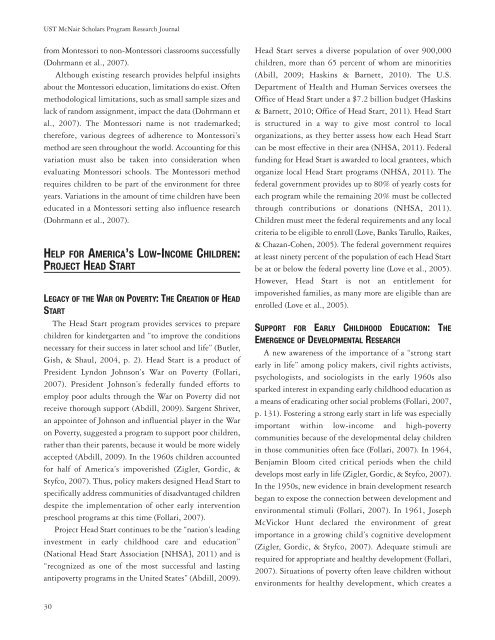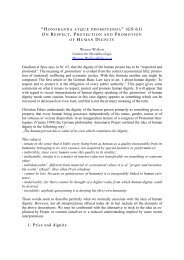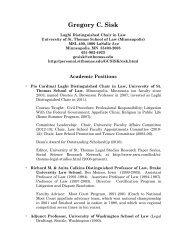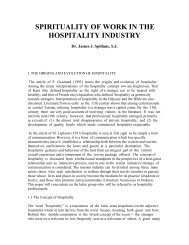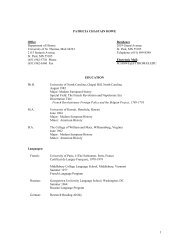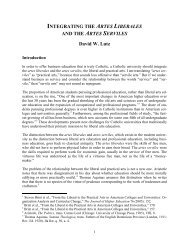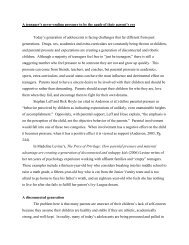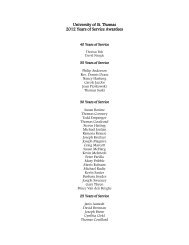dr. ronald e. mcnair acknowledgements - University of St. Thomas
dr. ronald e. mcnair acknowledgements - University of St. Thomas
dr. ronald e. mcnair acknowledgements - University of St. Thomas
Create successful ePaper yourself
Turn your PDF publications into a flip-book with our unique Google optimized e-Paper software.
UST McNair Scholars Program Research Journal<br />
from Montessori to non-Montessori classrooms successfully<br />
(Dohrmann et al., 2007).<br />
Although existing research provides helpful insights<br />
about the Montessori education, limitations do exist. Often<br />
methodological limitations, such as small sample sizes and<br />
lack <strong>of</strong> random assignment, impact the data (Dohrmann et<br />
al., 2007). The Montessori name is not trademarked;<br />
therefore, various degrees <strong>of</strong> adherence to Montessori’s<br />
method are seen throughout the world. Accounting for this<br />
variation must also be taken into consideration when<br />
evaluating Montessori schools. The Montessori method<br />
requires chil<strong>dr</strong>en to be part <strong>of</strong> the environment for three<br />
years. Variations in the amount <strong>of</strong> time chil<strong>dr</strong>en have been<br />
educated in a Montessori setting also influence research<br />
(Dohrmann et al., 2007).<br />
HELP FOR AMERICA’S LOW-INCOME CHILDREN:<br />
PROJECT HEAD START<br />
LEGACY OF THE WAR ON POVERTY: THE CREATION OF HEAD<br />
START<br />
The Head <strong>St</strong>art program provides services to prepare<br />
chil<strong>dr</strong>en for kindergarten and “to improve the conditions<br />
necessary for their success in later school and life” (Butler,<br />
Gish, & Shaul, 2004, p. 2). Head <strong>St</strong>art is a product <strong>of</strong><br />
President Lyndon Johnson’s War on Poverty (Follari,<br />
2007). President Johnson’s federally funded efforts to<br />
employ poor adults through the War on Poverty did not<br />
receive thorough support (Abdill, 2009). Sargent Shriver,<br />
an appointee <strong>of</strong> Johnson and influential player in the War<br />
on Poverty, suggested a program to support poor chil<strong>dr</strong>en,<br />
rather than their parents, because it would be more widely<br />
accepted (Abdill, 2009). In the 1960s chil<strong>dr</strong>en accounted<br />
for half <strong>of</strong> America’s impoverished (Zigler, Gordic, &<br />
<strong>St</strong>yfco, 2007). Thus, policy makers designed Head <strong>St</strong>art to<br />
specifically ad<strong>dr</strong>ess communities <strong>of</strong> disadvantaged chil<strong>dr</strong>en<br />
despite the implementation <strong>of</strong> other early intervention<br />
preschool programs at this time (Follari, 2007).<br />
Project Head <strong>St</strong>art continues to be the “nation’s leading<br />
investment in early childhood care and education”<br />
(National Head <strong>St</strong>art Association [NHSA], 2011) and is<br />
“recognized as one <strong>of</strong> the most successful and lasting<br />
antipoverty programs in the United <strong>St</strong>ates” (Abdill, 2009).<br />
30<br />
Head <strong>St</strong>art serves a diverse population <strong>of</strong> over 900,000<br />
chil<strong>dr</strong>en, more than 65 percent <strong>of</strong> whom are minorities<br />
(Abill, 2009; Haskins & Barnett, 2010). The U.S.<br />
Department <strong>of</strong> Health and Human Services oversees the<br />
Office <strong>of</strong> Head <strong>St</strong>art under a $7.2 billion budget (Haskins<br />
& Barnett, 2010; Office <strong>of</strong> Head <strong>St</strong>art, 2011). Head <strong>St</strong>art<br />
is structured in a way to give most control to local<br />
organizations, as they better assess how each Head <strong>St</strong>art<br />
can be most effective in their area (NHSA, 2011). Federal<br />
funding for Head <strong>St</strong>art is awarded to local grantees, which<br />
organize local Head <strong>St</strong>art programs (NHSA, 2011). The<br />
federal government provides up to 80% <strong>of</strong> yearly costs for<br />
each program while the remaining 20% must be collected<br />
through contributions or donations (NHSA, 2011).<br />
Chil<strong>dr</strong>en must meet the federal requirements and any local<br />
criteria to be eligible to enroll (Love, Banks Tarullo, Raikes,<br />
& Chazan-Cohen, 2005). The federal government requires<br />
at least ninety percent <strong>of</strong> the population <strong>of</strong> each Head <strong>St</strong>art<br />
be at or below the federal poverty line (Love et al., 2005).<br />
However, Head <strong>St</strong>art is not an entitlement for<br />
impoverished families, as many more are eligible than are<br />
enrolled (Love et al., 2005).<br />
SUPPORT FOR EARLY CHILDHOOD EDUCATION: THE<br />
EMERGENCE OF DEVELOPMENTAL RESEARCH<br />
A new awareness <strong>of</strong> the importance <strong>of</strong> a “strong start<br />
early in life” among policy makers, civil rights activists,<br />
psychologists, and sociologists in the early 1960s also<br />
sparked interest in expanding early childhood education as<br />
a means <strong>of</strong> eradicating other social problems (Follari, 2007,<br />
p. 131). Fostering a strong early start in life was especially<br />
important within low-income and high-poverty<br />
communities because <strong>of</strong> the developmental delay chil<strong>dr</strong>en<br />
in those communities <strong>of</strong>ten face (Follari, 2007). In 1964,<br />
Benjamin Bloom cited critical periods when the child<br />
develops most early in life (Zigler, Gordic, & <strong>St</strong>yfco, 2007).<br />
In the 1950s, new evidence in brain development research<br />
began to expose the connection between development and<br />
environmental stimuli (Follari, 2007). In 1961, Joseph<br />
McVickor Hunt declared the environment <strong>of</strong> great<br />
importance in a growing child’s cognitive development<br />
(Zigler, Gordic, & <strong>St</strong>yfco, 2007). Adequate stimuli are<br />
required for appropriate and healthy development (Follari,<br />
2007). Situations <strong>of</strong> poverty <strong>of</strong>ten leave chil<strong>dr</strong>en without<br />
environments for healthy development, which creates a


